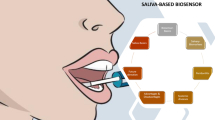Abstract
The effects of bovine lactoferrin (bLF) on the growth of Candida species and on inflammatory cytokine production in gingival keratinocytes, NDUSD-1 co-cultured with Candida strains were investigated. The results showed that bLF at 10 and 100 μg/mL significantly inhibits the growth of two C. albicans strains and two C. glabrata strains isolated from the saliva of elderly people requiring nursing care, respectively. The levels of inflammatory cytokines, interleukin (IL)-6, and IL-8 in NDUSD-1 co-cultured with each of these four Candida strains were measured. C. albicans tend to have a more potent capacity than C. glabrata to induce the production of the inflammatory cytokines in NDUSD-1. The levels of IL-6 and IL-8 in NDUSD-1 co-cultured with each of Candida species were measured after addition of bLF. bLF at concentrations from 1 to 100 μg/mL significantly inhibited the production of these cytokines in NDUSD-1 co-cultured with Candida species. These findings suggest that bLF may be useful in reducing the risk of aspiration pneumonia among elderly people requiring care for whom oral care is difficult.



Similar content being viewed by others
References
Garcia-Montoya IA, Cendon TS, Arevalo-Gallegos S, Rascon-Cruz Q. Lactoferrin a multiple bioactive protein: an overview. Biochim Biophys Acta. 2012;1820:226–36.
van der Strate BW, Beljaars L, Molema G, Harmsen MC, Meijer DK. Antiviral activities of lactoferrin. Antiviral Res. 2001;52:225–39.
Wang X, Hirmo S, Willen R, Wadstrom T. Inhibition of Helicobacter pylori infection by bovine milk glycoconjugates in a BAlb/cA mouse model. J Med Microbiol. 2001;50:430–5.
Ochoa TJ, Brown EL, Guion CE, et al. Effect of lactoferrin on enteroaggregative E. coli (EAEC). Biochem Cell Biol. 2006;84:369–76.
Arnold RR, Brewer M, Gauthier JJ. Bactericidal activity of human lactoferrin: sensitivity of a variety of microorganisms. Infect Immun. 1980;28:893–8.
Wakabayashi H, Yamauchi K, Kobayashi T, et al. Inhibitory effects of lactoferrin on growth and biofilm formation of Porphyromonas gingivalis and Prevotella intermedia. Antimicrob Agents Chemother. 2009;53:3308–16.
Takakura N, Wakabayashi H, Ishibashi H, et al. Oral lactoferrin treatment of experimental oral candidiasis in mice. Antimicrob Agents Chemother. 2003;47:2619–23.
Wakabayashi H, Abe S, Teraguchi S, Hayasawa H, Yamaguchi H. Inhibition of hyphal growth of azole-resistant strains of Candida albicans by triazole antifungal agents in the presence of lactoferrin-related compounds. Antimicrob Agents Chemother. 1998;42:1587–91.
Igarashi F, Uchida M, Tsutsui T. Establishment and characterization of cultured human gingival keratinocytes immortalized by transfection of origin (–) SV40 DNA and c-fos gene (in Japanese). Odontology. 1998;86:37–47.
Redding SW, Zellars RC, Kirkpatrick WR, et al. Epidemiology of oropharyngeal Candida colonization and infection in patients receiving radiation for head and neck cancer. J Clin Microbiol. 1999;37:3896–900.
Samaranayake LP, MacFarlane TW. Factors affecting the in vitro adherence of the fungal oral pathogen Candida albicans to epithelial cells of human origin. Arch Oral Biol. 1982;27:869–73.
Vermitsky JP, Edlind TD. Azole resistance in Candida glabrata: coordinate upregulation of multidrug. Antimicrob Agents Chemother. 2004;48:3773–81.
Li L, Dongari-Bagtzoglou A. Oral epithelium-Candida glabrata interactions in vitro. Oral Microbiol Immunol. 2007;22:182–7.
Kano R, Hasegawa A, Watanabe S, Sato H, Nakamura Y. Candida albicans induced interleukin 8 production by human keratinocytes. J Dermatol Sci. 2003;31:233–5.
Schaller M, Mailhammer R, Grassl G, et al. Infection of human oral epithelia with Candida species induces cytokine expression correlated to the degree of virulence. J Invest Dermatol. 2002;118:652–7.
Li L, Kashleva H, Dongari-Bagtzoglou A. Cytotoxic and cytokine-inducing properties of Candida glabrata in single and mixed oral infection models. Microb Pathog. 2007;42:138–47.
Bellamy W, Wakabayashi H, et al. Killing of Candida albicans by lactoferricin B, a potent antimicrobial peptide derived from the N-terminal region of bovine lactoferrin. Med Microbiol Immunol. 1993;182:97–105.
Okutomi T, Abe S, Tansho S, et al. Augmented inhibition of growth of Candida albicans by neutrophils in the presence of lactoferrin. FEMS Immunol Med Microbiol. 1997;18:105–12.
Dongari-Bagtzoglou A, Villar CC, Kashleva H. Candida albicans-infected oral epithelial cells augment the anti-fungal activity of human neutrophils in vitro. Med Mycol. 2005;43:545–9.
Baggiolini M, Walz A, Kunkel SL. Neutrophil-activating peptide-1/interleukin 8, a novel cytokine that activates neutrophils. J Clin Invest. 1989;84:1045–9.
Rossi D, Zlotnik A. The biology of chemokines and their receptors. Annu Rev Immunol. 2000;18:217–42.
Djeu JY, Matsushima K, Oppenheim JJ, Shiotsuki K, Blanchard DK. Functional activation of human neutrophils by recombinant monocyte-derived neutrophil chemotactic factor/IL-8. J Immunol. (Baltimore, Md: 1950) 1990; 144:2205–10.
Jones SA. Directing transition from innate to acquired immunity: defining a role for IL-6. J Immunol. (Baltimore, Md : 1950) 2005; 175:3463–68.
Borish L, Rosenbaum R, Albury L, Clark S. Activation of neutrophils by recombinant interleukin 6. Cell Immunol. 1989;121:280–9.
Oram JD, Reiter B. Inhibition of bacteria by lactoferrin and other iron-chelating agents. Biochim Biophys Acta. 1968;170:351–65.
Acknowledgments
We wish to thank Professor Takeki Tsutsui of the Pharmacology Department at the Nippon Dental University School of Life Dentistry at Tokyo both for his generous technical support and for providing NDUSD-1.
Conflict of interest
The authors declare that they have no conflict of interest.
Author information
Authors and Affiliations
Corresponding author
Rights and permissions
About this article
Cite this article
Komatsu, A., Satoh, T., Wakabayashi, H. et al. Effects of bovine lactoferrin to oral Candida albicans and Candida glabrata isolates recovered from the saliva in elderly people. Odontology 103, 50–55 (2015). https://doi.org/10.1007/s10266-013-0135-0
Received:
Accepted:
Published:
Issue Date:
DOI: https://doi.org/10.1007/s10266-013-0135-0




